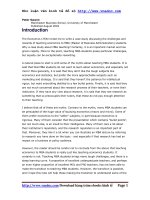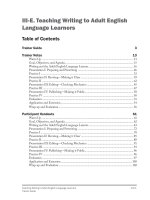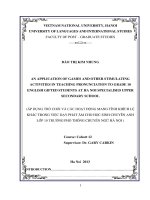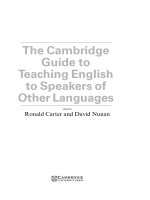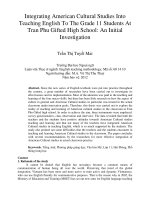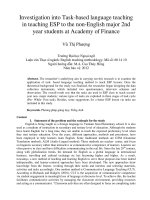Teaching student to use commas correctly, without boring them to tears
Bạn đang xem bản rút gọn của tài liệu. Xem và tải ngay bản đầy đủ của tài liệu tại đây (693.5 KB, 82 trang )
R ANDY L ARSON
Teaching the Boring Stuff Series
Commas is one of the first books in the new “Teaching the Boring
Stuff ” series. With short, easy-to-digest activities that have a sense of
humor, students learn to use commas correctly. At the same time,
they also learn a great deal about sentence structure.
No, this is not another book of dull drills. Commas presents material
in an interesting way, using language that makes sense to kids. Best
of all, it has students using what they learn.
Choose activities from the book here and there, as you see a
need. Or use them once or twice a week to build skills throughout
the school year. Either way, the review exercises will help reinforce
what students learn — and help them perform better on assessment
tests as well.
Teaching the Boring Stuff Series
Teaching students to use
commas correctly, without
boring them to tears
“In a job-shadowing summer training
seminar for high school teachers, I was
asked to do staff development with company CEOs. We used COMMAS.
The CEOs laughed, they learned, and
they loved it! (I was asked to do it again
next year, too!)”
R ANDY
L ARSON
—Wanda S. Caldwell
Tuscola Senior High School
Waynesville, North Carolina
COTTONWOODPRESS, INC.
I LLUSTRATED
BY
J UDY L ARSON
Teaching the Boring Stuff Series
COMMAS
Teaching Students to Use Commas Correctly,
Without Boring Them to Tears
Randy Larson
Illustrated by Judy Larson
Cottonwood Press, Inc.
Fort Collins, Colorado
Copyright © 1999 by Cottonwood Press, Inc. All rights reserved.
Permission is granted to reproduce activities in this book, in other than electronic form,
for the purchaser’s own personal use in the classroom, provided that the copyright
notice appears on each reproduction. Otherwise, no part of this work may be reproduced or transmitted in any form or by any means without written permission from
Cottonwood Press, Inc.
Requests for permission should be addressed to:
Cottonwood Press, Inc.
109-B Cameron Drive
Fort Collins, Colorado 80525
E-mail:
Web: www.cottonwoodpress.com
Phone: 1-800-864-4297
Fax: 970-204-0761
Print ISBN-13: 978-1-877673-38-2
E-book ISBN: 978-1-936162-01-7
Printed in the United States of America
T ABLE
OF
C ONTENTS
How to Use this Book ....................................................................................................................5
Comma Short Course—The Basics in 12 Easy Lessons ............................................................7
Commas after introductory elements ..................................................................................8
Commas with interrupting elements ..................................................................................12
Commas with ending elements............................................................................................14
Commas in a series ................................................................................................................16
Commas in compound sentences ........................................................................................18
Commas in addresses, dates, titles and letters ..................................................................20
Commas with coordinate adjectives ..................................................................................28
Practice Exercises and Quizzes ..................................................................................................31
Commas after introductory elements ................................................................................32
Commas with interrupting elements ..................................................................................37
Commas with ending elements............................................................................................44
Commas in a series ................................................................................................................48
Commas in compound sentences ........................................................................................52
Commas in addresses, dates, titles and letters ..................................................................56
Commas with coordinate adjectives ..................................................................................58
Cumulative Reviews and Test....................................................................................................61
Answer Keys ................................................................................................................................65
H OW T O U SE T HIS B OOK
No one wants to spend an entire year teaching commas. Although Commas may look, at
first glance, like “overkill,” it really is not. Commas is designed to be a resource book to
fit many situations. It is designed to teach the correct use of commas, of course, but
also much more—specifically, to teach students about sentence structure. It is designed
to give them practice writing and using language, while at the same time exercising their
imaginations and appealing to their sense of humor.
The book is divided into four sections:
COMMA SHORT COURSE. The lessons in the Short Course summarize the basics about
comma usage in sensible, easy-to-understand language. For many classrooms, the Short
Course is all that is needed to give students a basic working knowledge of comma
rules.
PRACTICE EXERCISES AND QUIZZES. Turn to page 31, “Practice Exercises and Quizzes,” if you
find that students need more work in a certain area. Here you will find supplementary
lessons, arranged according to subject area, that will give your students further practice.
For example, if you find that students need a better understanding of using commas in
a series, they can turn to pages 48–51, which include activities with the header
“Commas in a series.” Each subject area also includes a quiz.
CUMULATIVE REVIEWS AND TEST. The last section of the book includes cumulative reviews
and a cumulative test. These reviews and the test cover all the basics about the correct
use of commas.
ANSWER KEYS. Answer keys for all the exercises are included in the last section of the
book.
Commas can be used in a variety of ways, depending upon your classroom situation
and the needs of your students.
Reproduce the Short Course exercises for the overhead projector, and introduce a
lesson every week or so. Most lessons are short and can be done in ten or fifteen minutes. Follow up with practice exercises throughout the year to help students retain what
they have learned.
Or, if you prefer to do a complete comma unit at one time, select activities from the
book to suit the needs of your students. One idea is to use an activity from the Short
Course as a lesson on the overhead at the beginning of class, followed by a photocopied
lesson from “Practice Exercises and Quizzes” for students to complete on their own.
Commas sums up the rules about comma usage in a sensible, no-nonsense style that
won’t bore students to death. Don’t be surprised if they learn far more than with traditional exercises from your classroom textbook!
THE BASICS, THE BASICS, THE
BASICS, THE BASICS, THE BASICS,
THE BASICSC, OMMA
THE BASICS, THE
S
HORT C OURSE
BASICS, THE BASICS, THE BASICS,
T HE B ASICS IN 12
THE BASICS, THE BASICS, THE
E ASY L ESSONS
BASICS, THE BASICS, THE BASICS,
THE BASICS, THE BASICS, THE
BASICS, THE BASICS, THE BASICS,
THE BASICS, THE BASICS, THE
BASICS, THE BASICS, THE BASICS,
THE BASICS, THE BASICS, THE
BASICS, THE BASICS, THE BASICS,
USE A COMMA AFTER INTRODUCTORY ELEMENTS
IN A SENTENCE
Surprisingly, Maxine won first place at the Punctuation Festival
for her soothing new tune, “Comma Tose.”
Commas • Copyright © 1999 • Cottonwood Press, Inc. • 800-864-4297 • Fort Collins, Colorado
8
B ASIC
C OMMAS
F IRST
LESSON
1
AFTER INTRODUCTORY ELEMENTS
THINGS FIRST
Sentences often begin with a little something extra—a word that doesn’t quite flow
with the rest of the sentence. Sometimes that word is the name of the person you are talking to. Example:
Chandler, I would like to buy your ferret.
Sometimes it is a word like well, oh, or however—something that doesn’t quite fit
with the rest of the sentence. Example:
Well, I guess I’d like to try frog legs.
To show that a word is extra, it is set off with a comma. That means, of course, that
the comma goes after the word. A few more examples:
Marvella, would you marry me?
Yes, I would love to marry you.
Well, maybe I could marry you. Let me think about it.
Sam, it is possible that I may marry you. Let me think about it a few months.
Incidentally, Tyrone asked me to marry him last week.
No, I wouldn’t marry you if you were the last man on Earth.
P UNCTUATE
Add commas as needed to the sentences below. (If a sentence doesn’t need a
comma, don’t add one.)
1. Well I for one do not know any stand-up librarians.
2. Sadly he took his bassoon and went home.
3. No there’s nothing wrong with Aunt Louise.
W RITE
YOUR OWN
Write two sentences of your own, each beginning with an introductory word that
needs to be set off with a comma. Choose from these introductory words: however,
Tammy, yes, Jake, reluctantly, amazingly, besides, happily, no, why, my.
1. ____________________________________________________________________________
______________________________________________________________________________
______________________________________________________________________________
2. ____________________________________________________________________________
______________________________________________________________________________
______________________________________________________________________________
Commas • Copyright © 1999 • Cottonwood Press, Inc. • 800-864-4297 • Fort Collins, Colorado
9
B ASIC
C OMMAS
LESSON
2
AFTER INTRODUCTORY ELEMENTS
S HORT
STUFF
Many sentences begin with introductory “stuff” that doesn’t quite flow with the rest
of the sentence. Sometimes the “stuff” is a short group of words called a phrase or a
clause.* An introductory phrase or clause is set off from the rest of the sentence with a
comma. Examples:
In the back of the refrigerator, a moldy jar of mayonnaise sat beside a plate of
greenish-looking pork chops.
After sitting through five classes, Zachary didn’t really want to go with his
father to a lecture called “Fun with Calculus.”
P UNCTUATE
Add commas as needed to the sentences below. (If a sentence doesn’t need a
comma, don’t add one.)
1. Oddly enough I’ve grown fond of milk toast.
2. Practically speaking I wouldn’t own a blender if my life depended on it.
3. Although he denies it I’m not at all surprised that Paul ate your Jell-O.
W RITE
YOUR OWN
Write two sentences about something that is green, using any of the introductory
phrases below.
just for kicks • strangely enough • without thinking
in the middle of the day • in the middle of dinner
in the middle of the pond • after eating our dinner
1. ___________________________________________________________________________
_____________________________________________________________________________
2. ___________________________________________________________________________
_____________________________________________________________________________
* What is the difference between a phrase and a clause? A clause has a subject and a
verb. A phrase does not, though it may have either a subject or a verb.
Commas • Copyright © 1999 • Cottonwood Press, Inc. • 800-864-4297 • Fort Collins, Colorado
10
B ASIC
C OMMAS
L ONG
LESSON
3
AFTER INTRODUCTORY ELEMENTS
STUFF
Introductory phrases and clauses can be short, like By the way or When he laughed.
They can also be very long, sometimes even longer than the main part of the sentence.
Example:
By the time Angelo ate all the cheese dip and finished most of the chocolatecovered pretzels in the bowl on the coffee table, the party was over.
All of the words in bold are part of an introductory clause. The comma separates
these words from the main part of the sentence, which is the party was over.
Another example:
If you eat a lot of candy of any kind and never floss or brush your teeth,
your teeth may rot.
P UNCTUATE
Add commas as needed to the sentences below. (If a sentence doesn’t need a
comma, don’t add one.)
1. If you ever have a chance to meet my parakeet skip it.
2. While we watched Allison lunge for the aquarium that was about to topple off the
table we all held our breath.
3. In the event of a worldwide lettuce shortage eat cabbage.
W RITE
YOUR OWN
Add a long-winded introductory phrase or clause to each of the short sentences
below. Start your introductory phrase or clause with one of the words in the box. Be
sure to use commas correctly.
if • when • while • although • after • because
1. __________________________________________________________ I love oatmeal pie.
2. ________________________________________________________ she sleeps past noon.
3. __________________________________________ a skateboard would make a great gift.
Commas • Copyright © 1999 • Cottonwood Press, Inc. • 800-864-4297 • Fort Collins, Colorado
11
USE A COMMA TO SEPARATE AN INTERRUPTING ELEMENT
FROM THE REST OF THE SENTENCE
Millie Shimbo, the pastry chef for Moose Lodge #121, used a secret ingredient
in her Fluff Deluxe cookies.
Commas • Copyright © 1999 • Cottonwood Press, Inc. • 800-864-4297 • Fort Collins, Colorado
12
B ASIC
C OMMAS
LESSON
4
WITH INTERRUPTING ELEMENTS
I NTERRUPTERS
Here is a perfectly good sentence:
LaMont and his brother walked to school on Monday.
You already know that you could add an introductory word or group of words to
the beginning of such a sentence. Examples:
Yes, LaMont and his brother walked to school on Monday.
After they stopped at three convenience stores, LaMont and his brother
walked to school on Monday.
It is also possible to add a word or group of words somewhere in the middle of the
sentence, interrupting the flow of the sentence. Examples:
LaMont and his brother, incidentally, walked to school on Monday.
LaMont and his brother, by the way, walked to school on Monday.
LaMont and his brother, the one who usually drove his car, walked to school
on Monday.
Notice that the commas are placed on both sides of the interrupting word or words.
P UNCTUATE
Add commas as needed to the sentences below. (If a sentence doesn’t need a
comma, don’t add one.)
1. No one in the school however knew that Bill’s middle name was “Noodles.”
2. The Titanic an unsinkable ship sank.
3. My brother thinks that cauliflower the world’s friendliest vegetable goes well with
chocolate sauce.
4. Mrs. Gymtoe after being hypnotized by Professor Drool during an assembly fell off
the stage into a pile of seventh graders.
5. The most important thing the astronauts took to the moon not counting a ton of
powdered vegetables was a shiny roll of duct tape.
W RITE
YOUR OWN
Write three sentences about a space craft landing on your block. Include an interrupting element in each sentence.
______________________________________________________________________________
______________________________________________________________________________
______________________________________________________________________________
______________________________________________________________________________
Commas • Copyright © 1999 • Cottonwood Press, Inc. • 800-864-4297 • Fort Collins, Colorado
13
USE A COMMA TO SEPARATE AN ENDING ELEMENT
FROM THE REST OF THE SENTENCE
Miss Tugwell gave all her customers the same haircut, at least most of the time.
Commas • Copyright © 1999 • Cottonwood Press, Inc. • 800-864-4297 • Fort Collins, Colorado
14
B ASIC
C OMMAS
LESSON
5
WITH ENDING ELEMENTS
E NDING S TUFF
You have already learned about introductory words at the beginning of sentences
and interrupting elements in the middle of sentences.
“Stuff” can also be tacked on to the end of sentences. A word, a phrase or a clause
can come after the main part of the sentence. Examples:
I want another cookie, Mom.
I want it now, by the way.
My favorite kind of cookie is oatmeal, incidentally.
I love oatmeal cookies, the kind with both raisins and nuts.
Mom cooked a huge meal, at the same time balancing the check book.
P UNCTUATE
Add commas as needed to the sentences below. (If a sentence doesn’t need a
comma, don’t add one.)
1.
2.
3.
4.
5.
You are my fondest memory by the way.
I must have that lobster in the window the one with the sumptuous tail.
I never expected you to tell everyone Harvey.
You can’t go to the movies in that ridiculous outfit Melanie.
I like ridiculous outfits Mom.
W RITE
YOUR OWN
Write three sentences of your own that include ending “stuff.” Build all three sentences around the subject “annoying things that drive me crazy.” Choose from the following ending elements:
incidentally • on the other hand • Ellie
which makes me grit my teeth • the habit I hate the most
by the way • making me want to scream
______________________________________________________________________________
______________________________________________________________________________
______________________________________________________________________________
______________________________________________________________________________
______________________________________________________________________________
______________________________________________________________________________
Commas • Copyright © 1999 • Cottonwood Press, Inc. • 800-864-4297 • Fort Collins, Colorado
15
USE COMMAS TO SEPARATE ITEMS IN A SERIES
Fish, ice cream, burritos and coffee are the specialty
of the house at Eduardo’s Exquisite Cuisine.
Commas • Copyright © 1999 • Cottonwood Press, Inc. • 800-864-4297 • Fort Collins, Colorado
16
B ASIC
C OMMAS
L ISTS
AND
LESSON
6
IN A SERIES
L ISTS
Imagine seeing fish ice cream burritos and chocolate cake on the school menu. Fish ice
cream sounds bad enough, but fish ice cream burritos?
Commas can change the menu entirely. A menu with fish, ice cream, burritos and
chocolate cake sounds a little more appetizing.
The commas, of course, make the difference, serving as little dividers. Whenever
you have a list (or a series) of items, you need to separate them so that they don’t run
into one another. You can separate them with the words and or or, or you can separate
them with commas.* Example:
No:
Yes:
Calvin liked sausage cereal and prune tarts for breakfast.
Calvin liked sausage, cereal and prune tarts for breakfast.
or
Calvin liked sausage and cereal and prune tarts for breakfast.
P UNCTUATE
Add commas as needed to the sentences below. (If a sentence doesn’t need a
comma, don’t add one.)
1. Max is clever wise wonderfully funny and good with gorillas.
2. Uncle Farley is rich weird whiny and handy with a plunger.
3. Maria used her babysitting money to buy face powder bubble gum fly spray and
Oreos.
W RITE
YOUR OWN
Now write two sentences of your own that include a series. Make one of the sentences on the subject of sports and one on the subject of desserts.
1. ____________________________________________________________________________
______________________________________________________________________________
2. ____________________________________________________________________________
______________________________________________________________________________
* With the last item in a series, you can use a comma before the and if you want. In
many publications in the United States, that comma is not used anymore. Either way is
correct.
Commas • Copyright © 1999 • Cottonwood Press, Inc. • 800-864-4297 • Fort Collins, Colorado
17
USE A COMMA — ALONG WITH THE CONNECTING WORD
AND, BUT, OR, FOR, OR NOR — TO SEPARATE THE TWO
PARTS OF A COMPOUND SENTENCE
Ms. Maybird enjoyed her chickens, and she loved feeding them “brain food.”
Commas • Copyright © 1999 • Cottonwood Press, Inc. • 800-864-4297 • Fort Collins, Colorado
18
B ASIC
C OMMAS
LESSON
7
IN COMPOUND SENTENCES
C OMPOUNDS
Have you ever had a compound fracture in your arm or leg? A compound fracture
means you have not one but two breaks in your bone. A compound sentence means that
you have not one but two parts to your sentence. If you want to get fancy, you can call
those “parts” independent clauses.
Here’s a simple sentence with one independent clause:
Alexis ate an enchilada.
That sentence is a simple sentence. It is also an independent clause. That means it
can stand alone. Now let’s look at another independent clause:
Armand gobbled up four tacos and an order of refried beans.
That’s another simple sentence. It is also an independent clause.
Now, suppose we put the two sentences above together, with the word “and”:
Alexis ate an enchilada, and Armand gobbled up four tacos and an order of
refried beans.
Now we have two complete sentences (or independent clauses), connected with the
word and.
That brings us to a comma rule. In a compound sentence, put a comma before the
connecting word and, but, or, for, nor or yet.
P UNCTUATE
Add commas as needed to the sentences below. (If a sentence doesn’t need a
comma, don’t add one.) Remember, you only need the comma with the connecting
word if you are separating two independent clauses.
1. Turkeys are not exactly known for their great brain power and nobody thinks that
worms are likely to win scholarships to Harvard.
2. He hated television and music but he loved doing algebra equations more than anything on Earth.
3. Mary and Joe went on a hike up the Absolom Canyon on a beautiful fall day.
W RITE Y OUR O WN
Write two compound sentences of your own, using the subject things that go “splat.”
1. ___________________________________________________________________________
_____________________________________________________________________________
2. ___________________________________________________________________________
_____________________________________________________________________________
Commas • Copyright © 1999 • Cottonwood Press, Inc. • 800-864-4297 • Fort Collins, Colorado
19
USE A COMMA BETWEEN THE
DIFFERENT PARTS OF A DATE
To usher in the dog days of summer, Bernie married Polly
at the Purina Community Center on August 14, 1999.
Commas • Copyright © 1999 • Cottonwood Press, Inc. • 800-864-4297 • Fort Collins, Colorado
20
B ASIC
C OMMAS
LESSON
8
IN ADDRESSES , DATES , TITLES AND LETTERS
D ATES
Numbers can be confusing, especially when there are a whole string of them together.
That’s why we often use commas—to help make the numbers easier to read. For example, 520,000 is much easier to read than 520000.
The same thing holds true for dates. You need a comma between the day and the
year, just to make it easier to read. January 2 1999 might be misread, if you were in a
hurry, as January 21. Just to keep things straight, the comma is generally used. (Yes,
there are some new methods of writing dates that are becoming more common, like 21
January 1999. For most ordinary writing, however, the traditional commas between the
date and the year are used.)
Most people can remember that little comma between the day and the year. What
they don’t realize, quite often, is that there should be another comma after the year.
That comma sets the year off from the rest of the sentence. Examples:
Cheryl was born on February 2, 1949, in a little town in southern Colorado.
Damion began taking accordion lessons on October 23, 1996, because his grandfather thought he should carry on a family tradition.
P UNCTUATE
Add commas as needed to the sentences below. (If a sentence doesn’t need a
comma, don’t add one.)
1. On December 4 1289 a Roman teenager invented the world’s first dating service.
2. Years ago on November 1 1988 Elvira Twang decided that by January 12 2044 she
would have her own hypnotist’s shop in downtown Potato Springs.
3. When the mud races began on June 4 1995 Edna was ready with self-cleaning eyeglasses.
4. It was early on the morning of May 5 1888 that Alfred J. Oops learned the meaning of
the concept “hazardous waste.”
5. At midnight on August 13 1957 Alvin Andrews dreamed of frozen cabbage burgers.
W RITE
YOUR OWN
Write two sentences about dates that have some significance in your life.
1. ___________________________________________________________________________
_____________________________________________________________________________
2. ___________________________________________________________________________
_____________________________________________________________________________
Commas • Copyright © 1999 • Cottonwood Press, Inc. • 800-864-4297 • Fort Collins, Colorado
21
PLACE A COMMA BETWEEN EACH PART OF AN ADDRESS,
EXCEPT FOR THE STATE AND ZIP CODE
The ad read, “Antonio’s Blimp Painting School,
401 Last Avenue, Dillpot, Delaware 19898.”
Commas • Copyright © 1999 • Cottonwood Press, Inc. • 800-864-4297 • Fort Collins, Colorado
22
B ASIC
C OMMAS
LESSON
9
IN ADDRESSES , DATES , TITLES AND LETTERS
A DDRESSES
Commas are useful for separating things. In addresses, the commas help keep all the
different parts from running into one another.
For example, suppose you live at 126 Breakwater Drive, Timmonsville, Illinois
53321. The comma keeps the street address from running into the city. Another comma
keeps the city from running into the state. Another comma…oops! Why isn’t there a
comma keeping the state from running into the ZIP code?
Blame it on the U.S. Post Office. Until 1963, addresses didn’t have ZIP codes. Then the
rule was perfectly clear: Each part of the address was separated from the other parts with
a comma. In a perfect world, the post office would have been sensitive to students and
how hard it is to learn punctuation rules. It would have said, “Let’s separate the ZIP code
from the rest of the address with a comma, just as we do the other parts of the address.”
Unfortunately, the post office didn’t think about students. The people in charge
decided on no comma before the ZIP code.
So now, instead of a nice, simple rule like, “Place a comma between each part of an
address,” you get to learn a more complicated rule: “Place a comma between each part
of an address, except for the state and the ZIP code.”
Note: Some people don’t understand what is meant by a “part” of an address. The house
number and street are considered one part (126 Breakwater Drive). The city is another part
(Timmonsville). The state is another part (Illinois). The ZIP code is another (53321).
P UNCTUATE
Add commas as needed to the sentences below. (If a sentence doesn’t need a
comma, don’t add one.)
1. Send your complaints to Mary Snookum 141 Peewee Drive Hickory Arkansas 72065.
2. Please send my refund to 6543 Hullabaloo Lane Fort Almost Texas 78514.
3. No one can tell the future except the Snapple salesman who lives at 44321 Anxious
Avenue Mystic Florida 34221.
4. If your zeppelin lands a little early, stop by and see me at 99887 Elbow Lane
Loosejaw Alaska 99604.
W RITE
YOUR OWN
Write a sentence of your own that includes the complete address of a person you
know. Write another that includes the complete address of a place that you visit frequently.
______________________________________________________________________________
______________________________________________________________________________
______________________________________________________________________________
Commas • Copyright © 1999 • Cottonwood Press, Inc. • 800-864-4297 • Fort Collins, Colorado
23
USE A COMMA AFTER A NAME FOLLOWED BY JR., SR.,
OR ABBREVIATED TITLES LIKE M.D.
Mattie McGuire, Ph.D., was famous for her abbreviated
art technique called “splotch and splatter.”
Commas • Copyright © 1999 • Cottonwood Press, Inc. • 800-864-4297 • Fort Collins, Colorado
24
